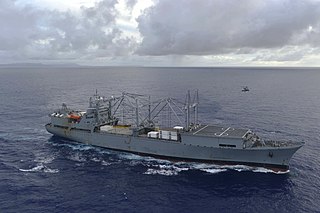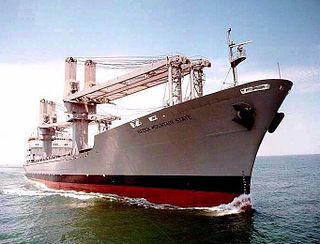USTS Empire State VI (T-AP-1001), callsign KKFW, IMO number 5264510, was a troop ship of the United States Navy and training vessel of the United States Maritime Service.

SS Curtiss (T-AVB-4) is one of two Wright-class aviation logistics support ship converted for the Military Sealift Command by Todd Shipyards in 1987.

USNS Bald Eagle (T-AF-50) was a Maritime Commission type C2-S-B1 cargo ship delivered to the War Shipping Administration (WSA) in May 1943. The ship was operated by WSA agent shipping companies until July 1948 when laid up in the James River Reserve Fleet briefly before beginning operation for the U.S. Army in October. When the Navy's Military Sea Transportation Service (MSTS) took over all military ocean shipping in 1950 the ship was transferred to operate as one of six refrigerated cargo ships in the MSTS fleet until July 1970 as USNS Bald Eagle. The ship was permanently transferred to Maritime Commission custody in September 1971 and sold for scrap in 1973.

David C. Shanks was a troop transport that served with the US Army during World War II as USAT David C. Shanks, and during the Korean War with the US Navy's Military Sea Transportation Service as the USNS David C. Shanks (T-AP-180).

The Type C4-class ship were the largest cargo ships built by the United States Maritime Commission (MARCOM) during World War II. The design was originally developed for the American-Hawaiian Lines in 1941, but in late 1941 the plans were taken over by the MARCOM.

SS Aquarama was built as Marine Star, one of five breakbulk cargo ships of the United States Maritime Commission (USMC) type C4-S-B5 having that C4 design variant. The ship was delivered to the War Shipping Administration (WSA) for operation in July 1945 just before the end of World War II and was operated until August 1946 by WSA's agent American Hawaiian SS Company. From September 1947 the ship was laid up except for brief periods in the James River.
USNS Flyer (T-AG-178), was a type C2-S-B1 cargo ship of the United States Navy, built for the Maritime Commission (MC) as Water Witch in service under charter by the commission to several lines until purchased in 1946 by United States Lines and renamed American Flyer. After being placed in the Reserve Fleet 14 December 1964 the title was transferred to the Navy for use as a deep ocean bathymetric survey ship supporting installation of the Sound Surveillance System (SOSUS). The Navy placed the ship in service 9 February 1965 with the name Flyer given on 22 March. The ship operated in that role until 1975.

SS Sea Marlin was a C3-S-A2 cargo ship operated for the War Shipping Administration (WSA) by Grace Lines during World War II. WSA allocated Sea Marlin to United States Army requirements. Sea Marlin was crewed by United States Merchant Marines, with a contingent of the US Naval Armed Guards for the guns and had a complement of the US Army Transportation Corps aboard for troop administration.

SS Grand Canyon State (T-ACS-3) is a crane ship in ready reserve for the United States Navy. The ship was named for the state of Arizona, which is also known as the Grand Canyon State.

SS Keystone State (T-ACS-1) is a crane ship in ready reserve for the United States Navy. The ship was named for the state of Pennsylvania, which is also known as the Keystone State.

SS Gem State (T-ACS-2) is a crane ship in Ready Reserve for the United States Navy. The ship was named for the state of Idaho, which is also known as the Gem State.

SS Equality State (T-ACS-8) was a crane ship of the United States Navy. The ship was named for the state of Wyoming, which is also known as the Equality State. She was scrapped in June 2019.

SS Green Mountain State (T-ACS-9) is a crane ship in ready reserve for the United States Navy. The ship was named for the state of Vermont, which is also known as the Green Mountain State.

SS Beaver State (T-ACS-10) is a crane ship in ready reserve for the United States Navy. The ship was named for the state of Oregon, which is also known as the Beaver State.
Horizon Lines, Inc. was an American domestic ocean shipping and logistics company headquartered in Charlotte, North Carolina. It was the largest Jones Act-compliant maritime shipping and logistics company, and accounted for approximately 37 per cent of all U.S. container shipments linking the continental United States to Alaska, Hawaii and Puerto Rico. Under the Jones Act, maritime shipments between U.S. ports is restricted to U.S.-built, owned, and flagged vessels operated by predominantly U.S.-citizen crews. The company originated from Sea-Land Service, Inc. The domestic liner operations of Sea-Land were sold in 2003 and thereafter operated under the name Horizon Lines. Horizon became a publicly traded company on the New York Stock Exchange in 2005. In 2015 the company was acquired by Matson Navigation Company.
The Type C7 ship(Lancer Class) is a United States Maritime Administration (MARAD) designation for a cargo ship and the first US purpose-built container ship. The vessels were constructed in US shipyards and entered service starting in 1968. As US-built ships they were Jones Act qualified for shipments between US domestic ports. Under the Jones Act, domestic US maritime trade is restricted to US-built and flagged vessels of US owners and manned by predominantly US-citizen crews. The last active Lancer container-configured ship was scrapped in 2019. Lancers of the vehicle Roll-on/Roll-off (RO/RO) configuration remain held in the Ready Reserve Force, National Defense Reserve Fleet and the US Navy Military Sealift Command. All are steam powered.

SS Mormachawk was a United States cargo vessel and troop ship during the Second World War operated by Moore-McCormack Lines as agents of the War Shipping Administration (WSA) from completion 14 December 1942 until placed in reserve after the war September 1946. The ship remained in the Columbia River reserve fleet at Astoria, Oregon until sold for scrapping in 1964.

SS Cape Gibson (AK-5051) was a Cape G Class Break bulk cargo ship of the United States Maritime Administration, last used as a training ship at Texas A&M University at Galveston before being scrapped in 2020.

The Type C5 ship is a United States Maritime Administration (MARAD) designation for World War II breakbulk cargo and later a container ship for containerization shipments. The first type C5-class ship was a class of ships constructed and produced in the United States during World War II. The World War II C5-class ship was dry bulk cargo ship built by Bethlehem Steel in Sparrows Point, Maryland. Bethlehem Steel built eight ships in this bulk cargo class and four orders were canceled. The C5-class ship has a 24,250 DWT and was 560 feet (170 m) long. The C5 was mainly used as iron ore carriers. The C5 was needed to replace other ships that sank during World War II. First in her class was SS Venore, USMC #1982, delivered on 20 July 1945. The Type C5-class ship designed to fill the need to move iron ore from Santa Cruz, Chile, to Sparrows Point, Maryland, through the Panama Canal, a round-trip of 8,700 nautical miles . Post World War II, four ships were given C5 class type C5-S-78a, these were roll-on/roll-off container ship built by Ingalls Shipbuilding, Inc. of Pascagoula, Mississippi and operated by the Moore-McCormack Lines. The C5-S-78a had a deadweight tonnage of 16,000 tons.
SS Bates Victory was a World War II Victory ship named after Bates College in Maine.














